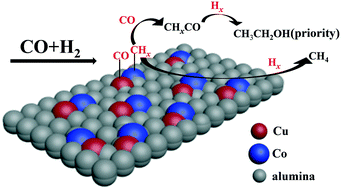Synergetic catalysis of bimetallic copper–cobalt nanosheets for direct synthesis of ethanol and higher alcohols from syngas†
Abstract
A series of bimetallic CuCo catalysts were synthesized through different preparation strategies and evaluated for ethanol and higher alcohol synthesis from syngas. The optimal CuCo catalyst, which has a Cu/Co ratio of 2/1, was derived from introducing Cu and Co elements at the same time into the layered double hydroxide (LDH) precursor. The uniformly dispersed CuCo catalyst with a small particle size exhibited markedly improved catalytic activity and ethanol selectivity (34.3%) with a narrow alcohol distribution of C1–C3 mixed alcohols (90.6%). As revealed by HAADF-STEM and in situ FTIR spectroscopy, the superior mixing of Cu and Co species exhibited a higher probability of CO bound in bridging geometries to neighboring metallic Co atoms, which was beneficial to enhance the amount of CHx intermediates. Moreover, the optimal CuCo catalyst exhibited a large specific surface area and an enrichment of copper. Meanwhile, temperature programmed surface reaction (TPSR) confirmed the weak hydrogenation probability of CHx to produce CH4 over the homogeneous dispersion of the CuCo catalyst, indicating that more CHx intermediates were utilized to produce ethanol.



 Please wait while we load your content...
Please wait while we load your content...